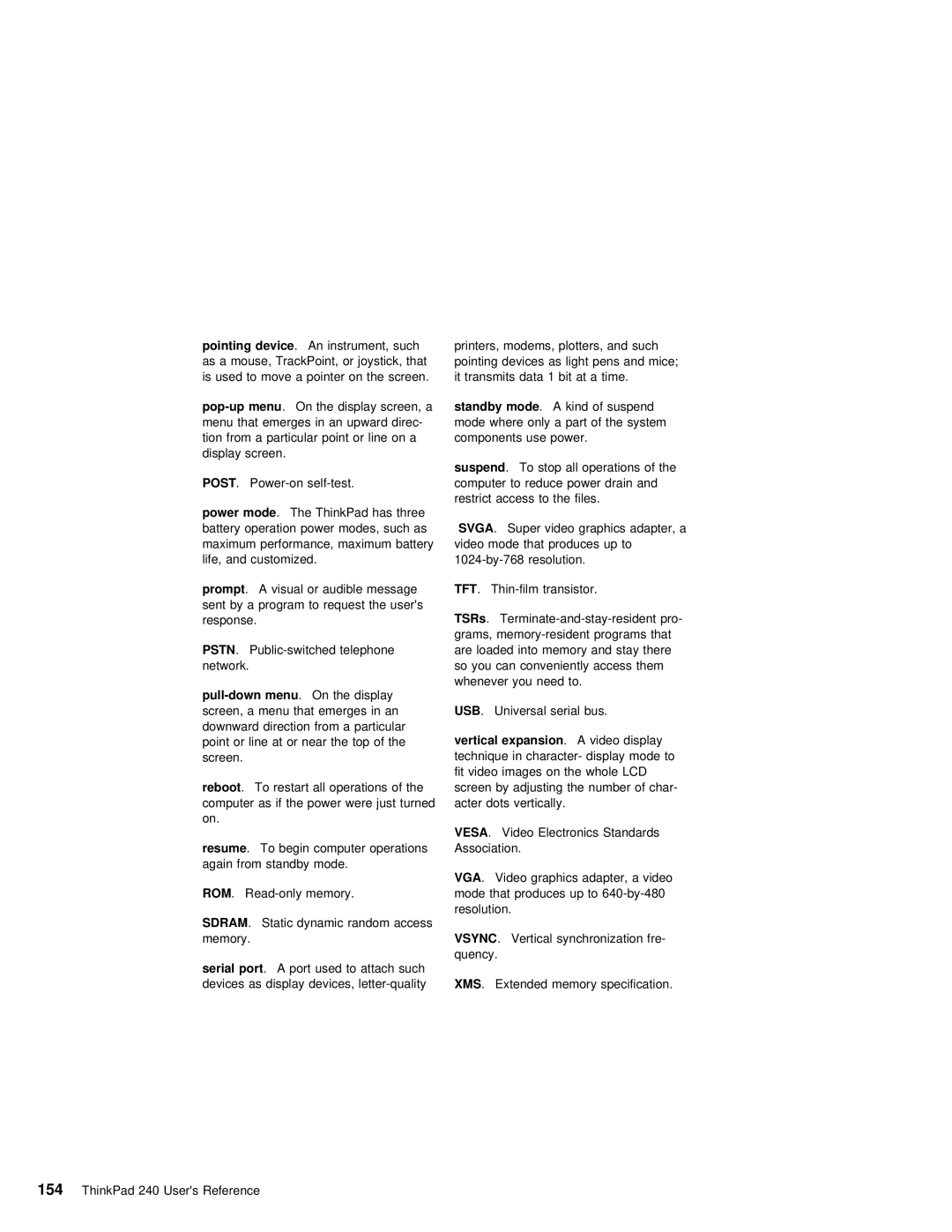pointing | device |
| . | An | instrument, | suchprinters, | modems, | plotters, | and | such |
| ||||||||||||||
as | a | mouse, | TrackPoint, or joystick,pointingthatdevices | as | light | pens | and | mice; | |||||||||||||||||
is | used |
| to | move | a | pointer | on | theit | transmitsscreen. | data | 1 | bit | at | a | time. | ||||||||||
menu |
| . | On the display screen,standby | amode |
| . | A | kind | of | suspend |
|
| |||||||||||||
menu | that | emerges | in | an | upward | only | a part of the system | ||||||||||||||||||
tion from a particular point or | componelinetsa use power. |
|
|
|
|
| |||||||||||||||||||
display | screen. |
|
|
|
|
|
|
| suspend . |
| To | stop all operations of the | |||||||||||||
|
|
|
|
|
|
|
|
|
|
|
|
|
| ||||||||||||
POST | . |
|
|
| computer | to | reduce | power | drain | and | |||||||||||||||
power | mode |
|
|
|
|
|
|
|
|
|
| restrict | access | to | the |
| files. |
|
| ||||||
| . | The | ThinkPad | has | three |
|
|
|
|
|
|
|
|
|
|
|
| ||||||||
battery |
| operation power modes, suchSVGA .as Super video graphics | adapter, a | ||||||||||||||||||||||
maximum performance, maximum batteryvideo mode that | produces | up | to |
| |||||||||||||||||||||
life, | and | customized. |
|
|
|
| resolution. |
|
|
|
|
| |||||||||||||
prompt . |
| A visual or audible messageTFT . |
|
|
|
|
| ||||||||||||||||||
sent by a program to request the user's |
|
|
|
|
|
|
|
|
| ||||||||||||||||
response. |
|
|
|
|
|
|
|
|
| TSRs . | pro- | ||||||||||||||
|
|
|
|
|
|
|
|
|
|
|
|
| grams, | that |
| ||||||||||
PSTN . | telephone | are | loaded | into | memory | and stay there | |||||||||||||||||||
network. |
|
|
|
|
|
|
|
|
|
| so you can conveniently access them |
| |||||||||||||
menu |
|
| . | On | the | display | whenever | you | need to. |
|
|
|
|
| |||||||||||
|
|
|
|
|
|
|
|
|
|
|
|
|
|
| |||||||||||
screen, a menu that emerges in | USBan . | Universal serial bus. |
|
|
| ||||||||||||||||||||
downward direction from a particular |
|
|
|
|
|
|
|
|
|
|
| ||||||||||||||
point | or |
| line at | or | near | the | topverticalof expansionthe | . | A | video | display |
| |||||||||||||
screen. |
|
|
|
|
|
|
|
|
|
| technique |
| in | character- display mode to | |||||||||||
|
|
|
|
|
|
|
|
|
|
|
|
| fit | video | images | on | the | whole | LCD |
| |||||
reboot | . | To | restart all operationsscreenof theby | adjusting | the | number | of | char- | |||||||||||||||||
computer |
| as | if | the | power | were acterjust | turneddots | vertically. |
|
|
|
|
| ||||||||||||
on. |
|
|
|
|
|
|
|
|
|
|
|
|
|
|
|
|
|
|
|
|
|
|
|
|
|
VESA . Video Electronics Standards
resume . To begin computer operatiAssociationns . again from standby mode.
|
|
|
|
|
| VGA | . | Video graphics | adapter, | a video |
ROM . | memory. |
| mode | that produces up | to | |||||
SDRAM |
|
|
|
|
| resolution. |
|
| ||
. | Static | dynamic | random | access |
|
|
| |||
memory. |
|
|
|
| VSYNC |
| . Vertical synchronization | fre- | ||
serial | port |
|
|
|
| quency. |
|
| ||
. | A port used | to attach | such |
|
| |||||
devices | as | display devices, | letterXMS | specification. | ||||||
